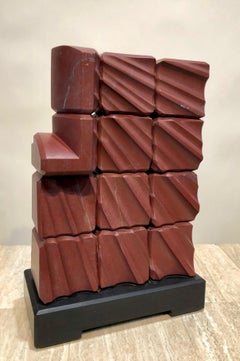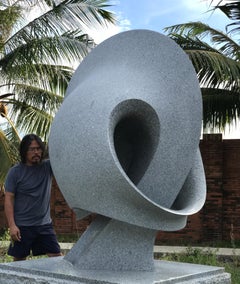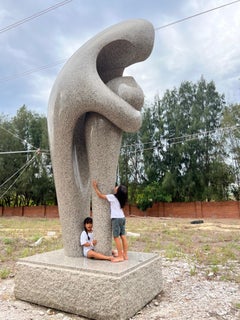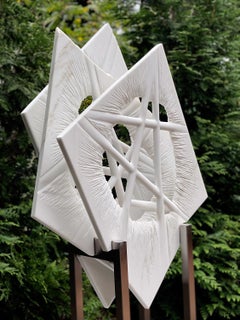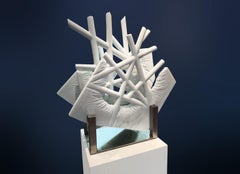Art by Medium: Stone
to
317
873
419
401
238
506
Overall Width
to
Overall Height
to
87
141
418
1,791
5
2
28
16
7
7
28
38
49
63
29
964
574
110
47
34
28
26
8
7
6
4
1
1
198
122
93
557
316
298
288
186
177
138
96
89
89
73
61
53
43
38
35
29
27
27
26
81,537
184,177
97,092
78,266
77,238
126
34
33
32
26
55
43
1,372
849
Medium: Stone
Red Ray, abstract sculpture, red Turkish Marble, black stone, geometric, carving
Located in Santa Fe, NM
Red Ray, abstract sculpture, red Turkish Marble, black stone, geometric, carving
Category
21st Century and Contemporary Contemporary Art by Medium: Stone
Materials
Marble
Night by Khang Pham-New, large abstract granite sculpture, grey, white, polished
Located in Santa Fe, NM
Night by Khang Pham-New, large abstract granite sculpture, grey, white, polished
This sculpture will take extra time for delivery. Co...
Category
2010s Contemporary Art by Medium: Stone
Materials
Granite
A Soul Consoled, Khang Pham-New, monumental, granite sculpture, mother and child
Located in Santa Fe, NM
A Soul Consoled, Khang Pham-New, monumental, granite sculpture, mother and child
Additional time will be added for works on this scale. Contact us or 1st Dibs to arrange for shipping details...
Category
2010s Contemporary Art by Medium: Stone
Materials
Granite
"INNER VIEW_Nexus_cellular", Organic, Abstract Marble Sculpture, Large Outdoor
Located in New York, NY
"INNER VIEW_Nexus_cellular" by Caroline Ramersdorfer
Marble and stainless steel
Shippable in 8-10 weeks. Please contact gallery for further information.
Ramersdorfer carves slabs o...
Category
21st Century and Contemporary Abstract Art by Medium: Stone
Materials
Marble, Stainless Steel
"INNER VIEW_Open_Nexus II" Organic, Abstract Marble Sculpture
Located in New York, NY
"INNER VIEW_Open_Nexus II" by Caroline Ramersdorfer
Marble and stainless steel
Shippable in 8-10 weeks. Please contact gallery for further information.
Ramersdorfer carves slabs of...
Category
21st Century and Contemporary Abstract Art by Medium: Stone
Materials
Marble, Stainless Steel
"INNER VIEW_Wings towards Reflection" Abstract Marble Sculpture, Large Outdoor
Located in New York, NY
"INNER VIEW_Wings towards Reflection" by Caroline Ramersdorfer
Marble and stainless steel
Shippable in 8-10 weeks. Please contact gallery for further information.
Ramersdorfer carv...
Category
21st Century and Contemporary Abstract Art by Medium: Stone
Materials
Marble, Stainless Steel
"Three Strikes" Abstract, Cast Stainless Steel Metal Sculpture by John Ruppert
By John Ruppert
Located in New York, NY
"Three Strikes" by John Ruppert
Rock, cast stainless steel from fragments of trees struck by lightning
Over the past 35 years, John Ruppert has been working in cast metals; manufact...
Category
2010s Abstract Art by Medium: Stone
Materials
Stone, Metal, Steel, Stainless Steel
Column, Unique Carved Marble and Stone Column Sculpture by Emile Gilioli
Located in Long Island City, NY
Artist: Emile Gilioli, French (1911 - 1977)
Title: Column
Year: circa 1960
Medium: Carved and Painted Marble on Marble Base, Signature Incised Verso
Size: 65.5 in. x 31 in. x 8 in. (...
Category
1960s Modern Art by Medium: Stone
Materials
Marble
TAKE A KNEEL FOR EQUALITEE. Contemporary Figurative Oil Painting
By Sax Berlin
Located in Brecon, Powys
In classic Sharp Edge 21st Century New York Style, Berlin acknowledges and shows solidarity with the world mourning the cruel death of George Floyd in the United States, and starting...
Category
2010s Street Art Art by Medium: Stone
Materials
Marble
Silhouette Embraced, Khang Pham-New, monumental abstract red granite sculpture
Located in Santa Fe, NM
Silhouette Embraced, Khang Pham-New, monumental abstract red granite sculpture
We first saw his sculptures when they were featured in an outdoor sculpture Biennale in Vancouver with many notable and established sculptors (like Magdalena Abakanowicz, Dennis Oppenheim, Albert Paley, Bill Reid, and Yoko Ono). His work stood out to us and we’ve represented Khang internationally ever since, exhibiting and placing his sculptures in public and private collections for the last 11 years. The response has been amazing. His abstract biomorphic shapes are contemplative and beautiful to view. Khang Pham was born in war-torn South Vietnam...
Category
2010s Contemporary Art by Medium: Stone
Materials
Granite
Infinity, monumental contemporary white granite sculpture by Khang Pham-New
Located in Santa Fe, NM
Infinity, monumental contemporary white granite sculpture by Khang Pham-New
white granite sculpture for outdoor or indoor installation. Sculpture garden ready with a connected base. Granite is durable and easy to care for and can withstand all climates. Polished surface is light grey/white.
We first saw his sculptures when they were featured in an outdoor sculpture Biennale in Vancouver with many notable and established sculptors (like Magdalena Abakanowicz, Dennis Oppenheim, Albert Paley, Bill Reid, and Yoko Ono). His work stood out to us and we’ve represented Khang internationally ever since, exhibiting and placing his sculptures in public and private collections for the last 11 years. The response has been amazing. His abstract biomorphic shapes are contemplative and beautiful to view.
Khang says: “It is my passion to create monumental sculpture. I invite the viewer to touch and interact with the work. It is especially nice to see small children in and around the large pieces.” Pham-New is interested in the art and form of sculpture as a basis for contemplation and meditation.
Khang Pham was born in war-torn South Vietnam...
Category
2010s Contemporary Art by Medium: Stone
Materials
Granite
Curvilinearity, monumental granite abstract sculpture Khang Pham-New outdoor
Located in Santa Fe, NM
Curvilinearity, monumental granite abstract sculpture Khang Pham-New outdoor
Khang Pham-New studied at the Ontario College of Art where he majored in sculpture installation. Amongst...
Category
2010s Contemporary Art by Medium: Stone
Materials
Granite
Orbit
Located in New York, NY
This is a kinetic piece where the top part rotates. Please contact us to receive a video file of it moving.
Gary manipulates the metal into breathtakingly balanced arabesques of seem...
Category
2010s Kinetic Art by Medium: Stone
Materials
Marble, Stainless Steel
Price Upon Request
Installation 3 blocks tower
Located in New York, NY
Untitled spaces series III
Installation 3 blocks tower, 2018
Neon Yellow concrete blocks. Variable dimensions
Category
2010s Contemporary Art by Medium: Stone
Materials
Concrete
Price Upon Request
White Marble Abstract Sculpture by Sergio Camargo
Located in Long Island City, NY
Artist: Sergio Camargo, Brazilian (1930 - 1990)
Medium: White Marble Sculpture, signature inscribed on base front
Size: 7.875 x 12.25 x 10.25 inches ; 2...
Category
1980s Abstract Geometric Art by Medium: Stone
Materials
Marble
Infinity, polished red granite sculpture, monumental
Located in Santa Fe, NM
Contact the gallery for information about commissions to enlarge or to order another color in granite
This is a unique sculpture done in a limited series of sizes and varying types ...
Category
2010s Contemporary Art by Medium: Stone
Materials
Granite
Price Upon Request
Escutcheon, large scale abstract granite sculpture by Khang Pham-New
Located in Santa Fe, NM
Escutcheon, large scale abstract granite sculpture by Khang Pham-New
The granite is so dense the quarry closed because it is harder than normal granite. Khang fell in love with the ...
Category
2010s Contemporary Art by Medium: Stone
Materials
Granite
Andromeda, white marble, female figure, waves, chain, nude, classical sculpture
Located in Santa Fe, NM
Andromeda, white marble, female figure, waves, chain, nude, classical sculpture
In Greek mythology, Andromeda is the daughter of Cepheus and Cassiopeia, king and queen of ancient Et...
Category
Early 2000s Contemporary Art by Medium: Stone
Materials
Marble
Escutcheon, by Khang Pham-New, gold granite, contemporary, abstract, sculpture
Located in Santa Fe, NM
Escutcheon, by Khang Pham-New gold granite, contemporary abstract sculpture
Polished yellow/golden granite abstract sculpture perfect for installation in a sculpture garden or ind...
Category
2010s Contemporary Art by Medium: Stone
Materials
Granite
PLANET BLUES
By Matthias Contzen
Located in New Orleans, LA
This sculpture will be exhibited at Scope Art Fair Miami Beach 2017
Category
2010s Abstract Art by Medium: Stone
Materials
Marble
Price Upon Request
Subject Object, John Reeves, limestone sculpture, circular, hand carved, garden
By John Reeves
Located in Santa Fe, NM
limestone sculpture
steel pin mounts to square base so it will turn
Category
2010s Contemporary Art by Medium: Stone
Materials
Limestone
Jesus Moroles, "Black Temple Totem, " Granite Sculpture, 1997
By Jesús Moroles
Located in Long Island City, NY
This sculpture was created by American artist Jesus Moroles (1950-2015). Moroles's works include both polished and natural granite surfaces in what he de...
Category
1990s Contemporary Art by Medium: Stone
Materials
Granite
Seeing the Sunset, Allan Houser pink Tennessee marble, abstract couple, Apache
By Allan Houser
Located in Santa Fe, NM
Seeing the Sunset, Allan Houser pink Tennessee marble, abstract couple, Apache
Seeing the Sunset, pink Tennessee marble, abstract couple, Apache Alla...
Category
1990s Contemporary Art by Medium: Stone
Materials
Marble
"Cumulus Stone No. 3" Large Abstract Carved Marble Sculpture, Mirror Base
Located in New York, NY
"Cumulus Stone No. 3" by Norman Mooney
Bardiglio Imperiale marble, stainless steel
In 1994 Mooney moved from Ireland to New York City and has been exhibiting locally and internation...
Category
21st Century and Contemporary Abstract Art by Medium: Stone
Materials
Stone, Marble, Steel, Stainless Steel, Metal
Naissance, monumental abstract granite sculpture by Khang Pham-New
Located in Santa Fe, NM
Naissance, monumental abstract granite sculpture by Khang Pham-New
Naissance, monumental granite sculpture polished, honed surfaces, Khang Pham-New
We first saw his sculptures whe...
Category
2010s Contemporary Art by Medium: Stone
Materials
Granite
Dance With Wisdom, Khang Pham-New, granite, abstract, sculpture, outdoor, indoor
Located in Santa Fe, NM
Dance With Wisdom, Khang Pham-New, pink, granite, abstract, sculpture, outdoor, indoor
Granite sculpture for outdoor or indoor installation. Sculpture garden ready with a connected base. Granite is durable and easy to care for and can withstand all climates.
We first saw his sculptures when they were featured in an outdoor sculpture Biennale in Vancouver with many notable and established sculptors (like Magdalena Abakanowicz, Dennis Oppenheim, Albert Paley, Bill Reid, and Yoko Ono). His work stood out to us and we’ve represented Khang internationally ever since, exhibiting and placing his sculptures in public and private collections for the last 11 years. The response has been amazing. His abstract biomorphic shapes are contemplative and beautiful to view.
Khang says: “It is my passion to create monumental sculpture. I invite the viewer to touch and interact with the work. It is especially nice to see small children in and around the large pieces.” Pham-New is interested in the art and form of sculpture as a basis for contemplation and meditation.
Khang Pham was born in war-torn South Vietnam...
Category
21st Century and Contemporary Contemporary Art by Medium: Stone
Materials
Granite
Cosmos, by Khang Pham-New, polished, granite, abstract, sculpture, outdoor
Located in Santa Fe, NM
Cosmos, by Khang Pham-New, polished, granite, abstract, sculpture, outdoor
Cosmos, polished granite abstract sculpture by Khang Pham-New outdoor sculpture
Light red granite sculpture for outdoor or indoor installation. Sculpture garden ready with a connected base. Granite is durable and easy to care for and can withstand all climates.
Khang Pham was born in war-torn South...
Category
2010s Contemporary Art by Medium: Stone
Materials
Granite
Embraced, Khang Pham-New, granite, abstract, folded, sculpture, outdoor, indoor
Located in Santa Fe, NM
Embraced, Khang Pham-New, granite abstract, folded, sculpture, outdoor indoor
Embraced, Khang Pham-New, granite abstract, folded, sculpture, outdoor art
Embraced, by Khang Pham-New, granite abstract, folded, sculpture, outdoor art
We first saw his sculptures when they were featured in an outdoor sculpture Biennale in Vancouver with many notable and established sculptors (like Magdalena Abakanowicz, Dennis Oppenheim, Albert Paley, Bill Reid, and Yoko Ono). His work stood out to us and we’ve represented Khang internationally ever since, exhibiting and placing his sculptures in public and private collections for the last 11 years. The response has been amazing. His abstract biomorphic shapes are contemplative and beautiful to view.
Khang Pham was born in war-torn South Vietnam...
Category
Early 2000s Contemporary Art by Medium: Stone
Materials
Granite
Painted Slate #6
Located in Laguna Beach, CA
Winston Roeth paints monochrome or two-toned panels on supports that range from slate, dibond, and honeycomb, to MDF and raw cedar, often combining them to form grids or rows of pane...
Category
1990s Minimalist Art by Medium: Stone
Materials
Slate
Price Upon Request
Painted Slate #5
Located in Laguna Beach, CA
Winston Roeth paints monochrome or two-toned panels on supports that range from slate, dibond, and honeycomb, to MDF and raw cedar, often combining them to form grids or rows of pane...
Category
1990s Minimalist Art by Medium: Stone
Materials
Slate
Price Upon Request
Inner View II
Located in New York, NY
"Inner View II" by Caroline Ramersdorfer
Marble, stainless steel
Shippable in 8-10 weeks. Please contact gallery for further information.
Ramersdorfer carves slabs of marble to rev...
Category
21st Century and Contemporary Contemporary Art by Medium: Stone
Materials
Marble, Stainless Steel
Price Upon Request
The Mystery of Majesty.
By Sax Berlin
Located in Brecon, Powys
Something so special it's hardly ever seen - creative silver and gold leafing. The face passed through seven stages before it was complete and crushed marble is used to adorn her fa...
Category
21st Century and Contemporary Contemporary Art by Medium: Stone
Materials
Marble, Gold Leaf, Silver Leaf
Price Upon Request
Emergence
Located in West Hollywood, CA
It is with great pleasure that we present the original works of American artist Robert Russin (1914-2007)
Robert Russin began his career as a WPA sculptor, and received dozens of...
Category
1980s Cubist Art by Medium: Stone
Materials
Marble
Price Upon Request
The Arch
Located in West Hollywood, CA
It is with great pleasure that we present the original works of American artist Robert Russin (1914-2007)
Robert Russin began his career as a WPA sculptor, and received dozens of ...
Category
1980s Modern Art by Medium: Stone
Materials
Marble
Price Upon Request
Lotus Buddha
By Sax Berlin
Located in Brecon, Powys
Sax Berlin is unique in using this natural material in this way - beautiful Italian slate. Created in the tranquil Japanese gardens and tea house which serve as his summer studio. This image could almost be a form of meditation in itself; gaze at the face and be drawn into the tranquility and depth of the Lotus Buddha...
Category
21st Century and Contemporary Contemporary Art by Medium: Stone
Materials
Slate
Price Upon Request
Globe 2
Located in San Francisco, CA
Edition 4 of 5
Category
21st Century and Contemporary Art by Medium: Stone
Materials
Marble
Price Upon Request
Globe 1
Located in San Francisco, CA
Edition of 5
Category
21st Century and Contemporary Art by Medium: Stone
Materials
Marble
Price Upon Request
Stone art for sale on 1stDibs.
Find a wide variety of authentic Stone art available on 1stDibs. While artists have worked in this medium across a range of time periods, art made with this material during the 21st Century is especially popular. If you’re looking to add art created with this material to introduce a provocative pop of color and texture to an otherwise neutral space in your home, the works available on 1stDibs include elements of blue, purple, green, orange and other colors. There are many well-known artists whose body of work includes ceramic sculptures. Popular artists on 1stDibs associated with pieces like this include John Van Alstine, Hsu Yun Chin, Gilbert Pauli, and Karine Benvenuti. Frequently made by artists working in the Contemporary, Abstract, all of these pieces for sale are unique and many will draw the attention of guests in your home. Not every interior allows for large Stone art, so small editions measuring 0.02 inches across are also available
